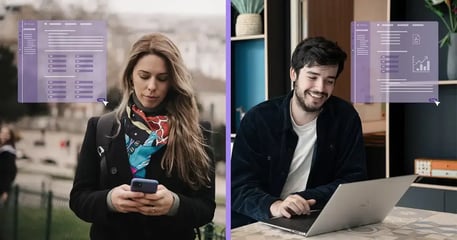Crafting that specific proposal, however, is not without its challenges. Complex requirements call for expertise. Writing requires time and teamwork. Coordination demands meticulous planning.
Bottom line, the time and effort you invest only pays off when you write a proposal that unlocks that door. This blog is your tender proposal writing guide. It will equip you with the writing steps and skills you need to unlock your next tender opportunity.
Understand Tender Requirements
Unlocking the door to this lucrative opportunity begins with understanding the client’s needs and priorities. Without thoroughly understanding both is like sitting for an exam without studying. You will miss key points.
Carefully read the Invitation to Tender (ITT) and:
- Understand all Requirements. Read the executive summary and project timeline for clues as to the client’s priorities. Highlight key themes as well as submission requirements and deadlines.
- Read Between the Lines. Deconstruct and scrutinize each question. Ask yourself, what are they really asking for, and why? Look for the implied meaning.
- Understand Evaluation Criteria. Read the requirements and questions again. This time with the tender proposal evaluation criteria in mind. What are they prioritizing? These are clues to what the client values.
- Clarify Ambiguity. Highlight anything that is ambiguous and discuss it with your team. Avoid opinions and interpretation. Leverage the ITT’s process for clarifying questions. Just be careful not to reveal anything strategic.
Suggested article: Proposal Writing With AI Software - Take the next step in tendering with AI trained on business data only, work faster without risking sensitive information.
Construct Your Tender Proposal Outline
Your outline is like a blueprint, ensuring a well-structured, well-intended and compliant tender proposal. Without one, you’ll end up with rooms in the wrong place. With the right outline, you’ll ensure compliance, leaving no detail behind.
Here is how to structure a tender proposal:
- Required Order. Do not stray from the outline mandated by the ITT. Instead, use the outline to your advantage. For example, showcase your ability to communicate value using headlines and images within the mandated outline.
- Logical Flow. Within the mandated outline, design a logical flow of information. Between sections, create coherent transitions. Both help readers follow your reasoning and turn the page.
- Impactful Visuals. Improve understanding by using visuals to support your content. A good rule of thumb; complex (flowcharts, drawings), some complexity (charts, graphics, timelines), simple (improve your visual appeal).
- Allocate Space. Allocate more writing space for where your solution shines and scores big. Strive for balance and contrast; help readers see and understand the relationship between items on the page.
Annotate Your Tender Outline
A common misconception is that experts know exactly how to respond to requirements and questions. While they certainly have the expertise, they are not always writers. Think of this step as guiding your team to write what you expect to read during the review.
Teams who begin with a pre-writing plan are more likely to deliver on expectations without rewriting.
- Map Requirements. Include how you and your team interpret the meaning and priority of each section. Map or link sections with overlapping content to drive consistency across your proposal.
- Strong Opening and Closing. Include direction for a compelling introduction that hooks the reader by clearly articulating your value proposition. Include direction on how to include a strong call to action that reiterates your qualifications..
- Plan for Visuals. Include ideas for integrating charts, graphics or images to present complex information in an easily digestible way.
- Optimize Your Score. Identify how each section will be scored. Then identify how your response can most strongly appeal to the key decision-makers. Include direction for quantifying your response using evidence, such as data and case studies.
Kick-off Your Proposal Writing
Proposal development is a team sport; relying on clear communication and seamless collaboration. That’s why the kick-off meeting is crucial. Here, you’ll assemble your dream team and lay the groundwork for successful proposal writing.
Here are some teamwork tips for a powerful start:
- Promote Understanding. Clearly communicate the client’s requirements, your value proposition and specifically what will increase your evaluation score. Ensure everyone on the team understands the project’s scope, objectives, and deadlines.
- Assign Roles and Responsibilities. Delegate tasks based on each team member’s strengths. A clear division of labor avoids confusion and ensures everyone contributes their expertise.
- Discuss Content Dependencies. At the same time, be sure everyone understands where their work overlaps with other expert tasks. When everyone understands where their piece of the puzzle fits, the team is more likely to collaborate and hit deadlines.
- Establish Communication Channels. Identify preferred lines of communication, for example, if tasks are reassigned or if the schedule changes. Some team members might prefer email over phone calls. Others might prefer text depending on the urgency.
- Schedule Milestones and Deadlines. Set realistic deadlines for different stages of proposal development. Schedule regular team meetings to keep everyone informed and to provide opportunities for questions and concerns.
Recommended article: Everything you need to know about proposal management
How to Write a Tender Proposal
A Tender exists as a procurement method for a contracting authority to evaluate vendors, and select the most suitable organization. Basically, it’s a competition.
A standout proposal grabs decision-maker attention, and sets your business apart from that competition. Increase your chances of unlocking that opportunity door by tailoring and personalizing your proposal.
Here are key elements of a winning tender proposal:
- Engage and Connect. Humanize your solution by connecting with the reader's frustrations and aspirations. Describe how you will help them overcome their fears and achieve their dreams.
- Educate Your Readers. Make it easy to understand your solution. Describe problems and how you solve them. Keep content relevant. Talk about the facts of action and consequences of inaction. And above all, support your claims with evidence.
- Persuade Your Readers. Make it easy to visualize the outcome. Clearly articulate how your solution will directly benefit the reader's bottom line or improve their situation. Unfold your story section by section, painting a clear picture of the positive impact your solution will have on their challenges and goals.
- Keep Language Simple. Showy words will not gain you extra evaluation points. They will, however, make your proposal harder to read and evaluate. Use simple words, for example “use” instead of “utilize.” And use visuals to reinforce your narrative.
- Provide Evidence. Unfortunately, it is not enough to say that you are the best business for the contract. Evaluators cannot rely on your word. Statistics and testimonials provide evidence of your claims. They make it easier for decision-makers to score, select and defend their decision.
Review and Edit to Improve Quality
When time is tight, the reviewing step can easily fall by the wayside. Hold firm. Your review team is your gatekeeper; they provide feedback on where the team may have blinded themselves to certain compliant issues and solution or strategy weaknesses.
Whether you schedule one or multiple reviews, leverage them to confirm accuracy, correct shortcomings and strengthen proposal quality.
- Involve a Mix of Reviewers. Leverage different types of reviewers to cover everything from accuracy and strategy to readability and scoring. You want feedback on where accuracy, compliance, and consistency are in jeopardy as well as how shortening sentences and adding bullets and visuals will improve understanding. Throw in some reviewers who are unfamiliar with the opportunity to gauge understanding.
- Set Reviewing Expectations. Be clear what you expect from your reviewers. “This needs more” is not actionable feedback. You want specific feedback that helps your team improve the accuracy and quality of your proposal. In addition, have reviewers score your proposal as they read. Have them identify areas for improvement, section by section, to increase your score.
- Prioritize Review Feedback. When it comes to proposal development, time is not always on your side. When there simply isn’t enough time to act on every review item, consider “hot washing.” A “hot wash”, or debrief, allows proposal managers to evaluate, clarify and prioritize exactly what should be incorporated into the proposal, and in what order, before your team takes action - and in the time available. For example, when time is short, proposal managers might prioritize compliance and accuracy issues over readability.
Avoid Common Tender Proposal Mistakes
You’ve poured your heart and soul into crafting a winning tender proposal. You’ve outlined a compelling approach, highlighted your expertise, and meticulously addressed every evaluation criterion.
Before you hit submit, take a deep breath. and ensure your hard work isn’t derailed by some common mistakes.
- Did you answer the question asked? In other words, don’t bury the answer in your requirement or question response. This forces the evaluators to play detective, which is likely to lower your score.
- Have you tailored your proposal? While portions of your proposal, such as management approach or project methodology, might be drawn from your reusables library, use caution. Evaluators expect more. They can spot boilerplate a mile away which makes them question your commitment.
- Is your proposal all about you? Prioritize the client's needs ahead of demonstrating your expertise. If too many paragraphs and sections begin with your business name, flip those around to lead with the client and their challenge.
- Does your proposal look professional? Submitting a proposal with typos, grammatical errors and sloppy formatting puts the wrong foot forward. Proofread and ensure a professional layout with visually appealing design elements. This ensures a good first impression, as well as a much easier read.
- Using too much technical jargon? Using overly technical language or ambiguous statements leave evaluators confused. Use simple language, and explain complex concepts in a way that is relevant to the project.
- Are names and terms consistent? With so much content, it’s easy to lose track of consistency. For example, the project is called by two or three different names throughout your proposal. Catching these mistakes before submission will maintain your credibility.
- Skipping lessons learned? Take time to debrief and identify areas for improving your tender proposal writing. For example, that review feedback you didn’t have time to incorporate? Use it to sharpen your team's writing on your next proposal.
Tender Proposal Writing Tools
When it comes to writing a tender proposal, there are a range of tools available to support your process. They can save valuable time for more quality writing by eliminating repetitive tasks and process detours. They can also enhance the overall quality of your proposal by boosting efficiency and productivity.
Writing tools for improving the quality and efficiency of your tender proposals:
- Content Management. Eliminate the blank page and recreating the wheel with a library stocked with accurate content, evidence and visuals. While portions of your proposal are surely unique, there are typically some questions that are common. Leveraging reusable content for common questions and requirements buys you more time to focus on the unique aspects of your proposal.
- Writing Software. Easing team collaboration boosts efficiency by eliminating the hoops experts must jump through to connect. Co-authoring connects your team real-time so they can see what everyone is working on, confer and build off each other's experience. This approach also facilitates writing and reviewing in-parallel, which accelerates the writing process. For managers it's also a boon because they can keep their finger on the pulse of progress and status without having to ask.
- Smart Document Builders. For faster turnarounds on less complex tender proposals, consider a smart document builder. These self-guided, step-by-step questionnaires leverage your content library for accuracy and consistency. They typically include the benefits of co-authoring and automation, and allow teams to bid more with the same staff.
- Automation. Skip the document set-up and ditch the coordination and formatting with RFP response software. Automating these repetitive tasks, as well as data entry, task and deadline changes, emails and version control, frees up more time to focus on the strategic aspects that truly unlock opportunities.
- Artificial Intelligence (AI). Identify relevant content faster so you can invest more time in proposal clarity and quality. Your proposal team leverages a mountain of big data to write. Today's AI software is transforming that mountain into faster, actionable insights. Just use it wisely; AI is an assistant, not a replacement for the human experience.
Now you hold the key to cracking the proposal writing code. Take a deep breath, put your newfound know-how to the test, and get ready to unlock the door to your next lucrative project.











